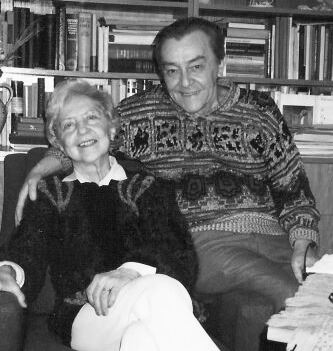Dr. Jan Bureš and his work at IPHYS
Jan Bureš started his scientific work as a student of the Faculty of Medicine under the guidance of Zdeněk Servít, the Associate Professor. His first research topic was epilepsy - in the early fifties, of course, the reflex epilepsy. Dr. Bureš soon became an independent researcher and started the first major chapter of his research activity by beginning to study the phenomenon and mechanisms of spreading depression of electroencephalographic (EEG) activity.
In this field he published many fundamental papers, mainly on the mechanism of the depression wave origin, the role of potassium ions and the propagation of the depression wave, as well as on the possibilities of blocking this propagation. These works often used electrophysiological methods. He also addressed the relationship between spreading depression and terminal anoxic depolarization. His research papers on the ontogenetic development of spreading depression in the cerebral cortex and hippocampus are highly original. When the ion-selective electrode method became available, he initiated and co-authored a publication definitively proving the fundamental role of potassium ions in the phenomenon of spreading depression. The publication deservedly earned its authors the designation of citation classics. Despite the fact that Dr. Bures has become a recognized authority on the subject of the spreading depression of EEG activity, he was not satisfied with his achievements and therefore decided to initiate yet another research in a completely different area of neuroscience.
He used spreading depression as a method of temporarily disabling brain structures in the areas of learning and memory. His works published in collaboration with his wife Olga resemble precisely solved chess problems - they successfully analysed the formation, transmission and recollection of memory traces. However, Dr. Bureš did not stay with this theme permanently either and once again fundamentally changed the focus of his research. Since the 1980s, he has been working on the topic of spatial navigation, i.e. the ability of animals to find destinations in their environment, which can be considered an animal analogy of human declarative memory. In the field of spatial navigation, Dr. J. Bureš has thus pioneered groundbreaking ideas and developed several pivotal behavioural approaches. He refined the concept of lateralization and transfer of memory traces; in this specific case it was that by selective functional blockade of nervous tissue in one half of the brain, he "made the memory trace" reside only in one hemisphere of the brain, from where it could only move to the other hemisphere under certain conditions. Dr. Bureš also developed major innovations in the behavioural study, such as a so-called radial water maze, in which the rat swam and searched for an island hidden in one of the arms of the maze, and also a so-called "on-demand platform". The on-demand platform consisted of an islet buried deep below the surface; only if the swimming rat stayed in the target area for a certain period of time did the islet "surface" and allow the animal to rest. Interestingly enough, the inventor of the water maze, the explorer Richard Morris, revived this innovation a few years later and conducted several seminal studies with it under the name of Atlantis platform. Since the 1990s, Dr. Bureš has been studying so-called place cells, neurons signalling the current position of an animal in the brain. He published several papers still widely cited today and advanced a revolutionary concept that place cells needed to be measured primarily in spatial tasks in order to understand their role in navigation; up until then in the 1990s, researchers studied these neurons only in arenas where animals moved randomly.
Dr. Jan Bureš was appointed a member of the American Academy of Sciences in 1995, having gained this appointment as the first and only Czech living permanently outside the USA. Despite his merits and prestige, he remained a modest and open-minded person for whom science was an exciting mission, and he remained active until the end of his career, devoting himself to his young colleagues. Throughout his life he has inspired countless young adepts with his love of science and knowledge, thanks to his extremely personal and human approach, which was not lacking in subtle but very liberating humour.
text: Aleš Stuchlík and Pavel Mareš

Jan Bureš and his wife Olga
